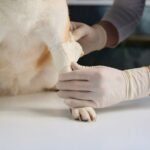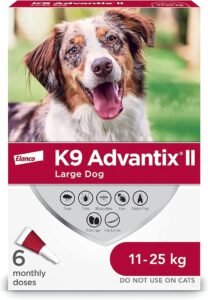It’s common for pet parents to be given multiple treatments to try for their pet’s skin irritation and yet they still don’t seem to resolve the issue. The very first thing that needs to be done is to figure out what infections are at play. Here I go over three important steps to diagnosing skin problems in dogs.
1. Ask your veterinarian to perform a skin scraping and tape prep.
A skin scraping is a quick, inexpensive test that is performed in the clinic whereby your dog’s skin is scraped with a scalpel and the material collected is looked at under a microscope. This simple test can identify ectoparasites on the skin, bacteria, mites and yeast along with other entities. I would also consider having a tape prep performed at the same time. It helps look for yeast which is another infection that dogs can have chronically and be mistaken for allergies.
If only yeast is present then you can start by bathing your dog daily with an anti-fungal shampoo. Leave the shampoo on for 10 to 15 minutes before rinsing it off. You’ll have to do this for a number of weeks because yeast is very stubborn. If this doesn’t work, and that should be confirmed by a repeat skin scraping at the end of the treatment, then you can look into giving an anti-fungal oral medication. This type of medication can be a bit hard on the liver so you’ll want to do some blood testing before starting and also during the treatment. If there is hair loss and it has a circular pattern, I would recommend that your veterinarian perform a fungal culture to look for ringworm.
If the skin scraping reveals bacteria in addition to yeast, I would recommend that you use an antibiotic concurrently (see step 2 for determining the antibiotic). If only a bacteria is present again you can start out by by bathing your dog with an antibacterial scrub or antibacterial shampoo and start treating it daily. If the bacteria is still present on a repeat skin scraping then I would recommend you perform the next test in step two on our list.
If there is a skin parasite present, it can be identified with the skin scraping and an appropriate treatment with medication can begin.
2) If bacteria is present, have a skin culture and sensitivity test performed.
If the skin scraping reveals the presence of bacteria then the next thing I would recommend is a skin culture and sensitivity test. This is where you swab the skin with a Q-tip, send it to the lab and it will grow whichever bacteria is present on the skin and expose it to different antibiotics to figure out which one will resolve it. There are infections that can have multiple bacteria or resistant bacteria and knowing this will allow your veterinarian to formulate an ideal plan.
3) Focus in on treating allergies.
You’ll notice that allergies are mentioned last. You cannot be certain about allergies in any way until the infections are evaluated, confirmed and eliminated. Once you have eliminated the infectious agents, you’re then left with allergies to deal with. If allergies are at the root of this problem then you may have observed that it is occurring seasonally or that it quickly recurs after a treatment for a simple bacterial or yeast infection.
Consider doing something simple that may help, such as changing the diet to a different food with a different protein and carbohydrate source. If it happens to be a food allergy, you may get lucky and resolve it just with this. But keep in mind that allergies are much more complex than just changing the diet and there are often multiple treatments, supplements, shampoos, diets and other strategies used in combination to address this problem.
The importance of these tests cannot be overstated. As always please consult your veterinarian as the next step before moving forward. I strongly recommend having a serious discussion to ensure that the right diagnostic testing is completed and correct treatment is performed.











